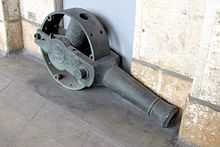Revolver cannon



History
An early, but impractical precursor was the Puckle gun of 1718—a large flintlock revolver gun. The design idea was far ahead of what was technologically achievable at the time; the first practical autocannons used different principles. It wasn't until the mid-1940s that the first practical revolver cannons emerged.[1]
During the 19th century, Elisha Collier and later Samuel Colt used the revolver action to revolutionize handguns. The Confederate States of America used a single 2-inch, 5-shot revolver cannon with manually rotated chambers during the Siege of Petersburg, where it was captured by the Union forces.[2] In 1905, C. M. Clarke patented[3] the first fully automatic, gas-operated rotary chamber gun, but his design was ignored at the time. Clarke's patent came at time when reciprocating-action automatic weapons like the Maxim gun and the Browning gun were peaking in popularity.[4]
The archetypal revolver cannon is the Mauser MK 213, from which almost all current weapons are derived. In the immediate post-war era, Mauser engineers spread out from Germany and developed similar weapons around the world; both the British and French made outright copies of the 30 mm versions of the MK 213 as the ADEN and DEFA, respectively, Switzerland produced the Oerlikon KCA, while the U.S. used the 20 mm version, re-chambered for a slightly longer 102 mm cartridge intermediate between the 213's 82 mm and Hispano-Suiza HS.404's 110 mm. A number of larger experimental weapons were also developed, like the 42 mm Oerlikon RK 421, but did not see service.[5]
Several generations of the basic ADEN/DEFA weapons followed, remaining largely unchanged into the 1970s. At that point a new generation of weapons developed, either for the proposed NATO 25 mm caliber standard, or based on the Mauser 27 mm round; the leading current example is arguably the Mauser BK-27. The Rheinmetall Millennium 35 mm Naval Gun System is the largest to see service.[6] The French GIAT 30 is a newer generation power-driven revolver cannon, and the Rheinmetall RMK30 modifies the GIAT system further by venting the gas to the rear to eliminate recoil.
The Hotchkiss Revolving Cannon of the late 19th century was not a revolver cannon in the modern sense, being of a Gatling type. Arguably, a forerunner was the Puckle gun, which was a manual revolver cannon, as opposed to an automatic one.
Today, the revolver cannon is practically the only multiple-chamber, single-barrel design in use. However, during the American Civil War, an alternative idea to a rotating set of chambers was the "Coffee Mill" Agar gun, in which the preloaded chambers were brought in front of the barrel from a funnel similar in appearance to a Burr mill.[7]
Soviet revolver cannons are much less often encountered than Western ones, especially on aircraft. Around 1935, Silin, Berezin and Morozenko worked on a 6000 rpm 7.62 mm aircraft machine gun using revolver design, called SIBEMAS (СИБЕМАС), but this was abandoned.[8] Another mechanism for a Soviet revolver-based machine gun was patented in 1944.[9] The virtually unknown Rikhter R-23 was fitted only to some Tu-22 models, but later abandoned in favor of the two-barrel, linear action Gryazev-Shipunov GSh-23 in the Tu-22M. The Rikhter R-23 does have the dubious distinction of being fired from the space station Salyut 3. The Soviet navy has also adopted a revolver design, the NN-30, typically in a dual mount in the AK-230 turret.
Characteristics
Automatic revolver cannons generally have a lower maximum sustained rate of fire than Gatling guns, as all the rounds are fired through a single barrel, which suffers from much higher heating loads. Cannon caliber Gatling guns have a rate of fire of up to 10,000 rounds per minute (such as the Gryazev-Shipunov GSh-6-23), while revolver cannons typically have a rate of fire of up to 2,000 rounds per minute. On the other hand, revolver cannons generally have a high initial firing rate due to the lower moving mass involved - only the chambers are being spun. Gatling type guns spin the whole multiple barrel and breech assembly which in equal caliber versions can weigh hundreds of kilograms. Also, the external power source of US Gatling guns provides less power in a burst than the gas-operation of a revolver cannon[citation needed], so that about half a second of spin-up time is required until the maximum rate of fire is reached. As it avoids the additional weight of multiple barrels, a revolver cannon can fire a larger caliber projectile than a Gatling gun of the same weight.
See also
- ShVAK cannon
- ShKAS machine gun
- Mauser MK 213
- MANTIS - The German Army's new very short range protection system
- Skyshield
- Rheinmetall RMK30
- ADEN cannon
- DEFA cannon
- M39 cannon
- GIAT 30
Notes and references
- ↑ Anthony G. Williams (2002). Rapid Fire: The Development of Automatic Cannon, Heavy Machine-Guns and Their Ammunition for Armies, Navies and Air Forces. Airlife. p. 50. ISBN 978-1-84037-435-3.
- ↑ George M. Chinn (1951). The Machine Gun, History, Evolution and Development of Manual, Automatic and Airborne Repeating Weapons, Vol. 1. U.S. Government Printing Office. p. 46.
- ↑ http://www.google.com/patents/US794852
- ↑ Chinn, p. 182
- ↑ Anthony Williams, "The Red Queen and the Vigilante"
- ↑ The British were developing a 42 mm revolver cannon in the 1950s before cancelling in favour of missiles
- ↑ Chinn, p. 185
- ↑ Болотин, Давид (1995). История советского стрелкового оружия и патронов. Полигон. p. 235. ISBN 5-85503-072-5. (Russian)
- ↑ Пулемет с барабанным камерным питанием А.И. Коновалова. 1944 г.Авторское свидетельство 66799 МВС.
- George M. Chinn (1955). The Machine Gun: Design Analysis of Automatic Firing Mechanisms and Related Components, Volume IV, parts X and XI. Bureau of Ordnance, Department of the Navy, US Government Printing office. pp. 178–209.